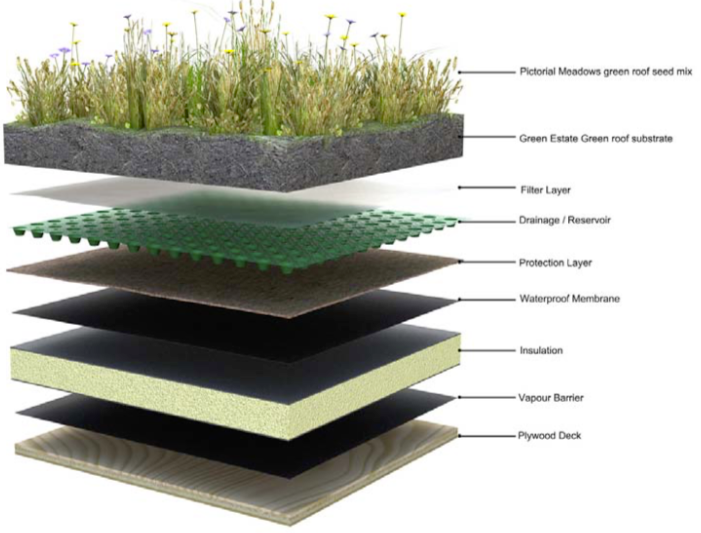Roofs in urban areas can be very valuable real estate. Besides protecting occupants from the elements, they can also be used for amenity space, hosting cell towers, HVAC equipment, window washing anchors, skylights, compact wind turbines, … just to name a few. Adding to these competing interests are new environmental requirements for buildings to integrate solar PV and stormwater mitigation improvements, such as green roofs. Thankfully new technology allows solar panels to coexist harmoniously in the same area, freeing up roof space for other purposes.
Green Roof Basics
For those unfamiliar with them, a green roof is a system that retains water and allows vegetation to grow on top of a building. While some green roofs produce edible food, the primary purpose of green roofs is to prevent stormwater from overloading a city’s sewer system. See diagram below for detail the various layers of a common green roof.

Because they hold so much water, the weight of green roofs is a major concern for architects and structural engineers. At the low end, they usually add 13 pounds per square foot. Deeper media green roofs can add as much as 50 pounds per square foot.
Green Roof Solar Integration
For perspective, conventional flat roof ballasted solar PV only weighs around 4 to 6 pounds per square foot. A green roof integrated solar PV system can work two ways:
- The solar array directly attached to the roof substructure (multiple penetrations underneath a bio-retention system causes obvious concern to building owners and roof warranty providers alike)
- The solar array uses the green roof medium as the ballast for the panels and eliminates the need for additional ballast like cinder blocks. Thus, the marginal weight of the panels on a green roof is significantly lower than that of a traditional ballasted PV system.
While conceptually, #2 doesn’t seem complicated to integrate these two technologies, the reality is not so simple. A green roof and an integrated solar PV system should be thought of as a single system and should be procured and designed concurrently; especially given the fact that most green roofers do not install solar, and most solar installers do not install green roofs.
A core function of green roofs is to provide reliable storage and drainage of the green roof soil. Given that PV systems often conduct high voltage electric current, it’s imperative that the electrical infrastructure is designed in harmony with the green roof drainage system. When designed properly, the drainage system can actually increase PV system performance by cooling the components and boosting efficiency.
Another important consideration is the plant species that’s being used for the green roofs vegetation. The plantlife is competing for sunlight with the solar panels and as such, so will need to do well in the shade. For passive green roofs, succulents are generally preferable as they don’t grow too high and retain a lot of water. For rooftop gardens that are near the PV array, consider lettuce, chard, broccoli, beets, or herbs that grow well in your local climate.
Honeydew is Here to Help you with Your Green Roof Solar Projects
There are many other more subtle design choices that must be considered when integrating solar PV with a green roof, including permitting with the local zoning authority. If you are working on a project that requires both of these systems, please contact us using the form below and we can provide industry leading solutions to meeting your project goals.

